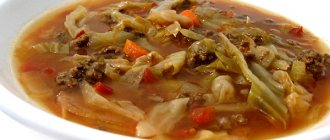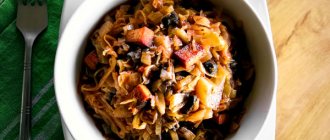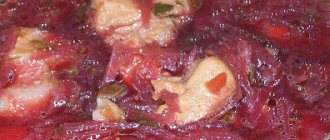What to cook with cabbage? - this is a question that many people periodically ask themselves. And I'm no exception. Once you master a few successful dishes, you usually stop expanding your menu. What for? After all, everything turns out delicious anyway. At one time I regularly made cabbage salads - sometimes with peas, sometimes with tomatoes, sometimes with chicken and nuts. I fried finely shredded cabbage with onions, boiled it cut into squares and mixed it with butter and egg. All this was very tasty, until one day I suddenly discovered that I had not bought cabbage for a long time. And I understood why: yes, because I was tired of the usual dishes. It's time to try something new. But what? My mind immediately started spinning around the disgusting cabbage cutlets that my ex-husband liked. No, not this. Maybe cabbage rolls? But this is a half-day fuss. But I want a big saucepan, something tastier, and not just for one day...
Homemade sauerkraut is the most delicious
And then I remembered that when I was still in college, my mother made some absolutely amazing instant cabbage. Like sauerkraut, only with vinegar. I immediately called to find out the recipe. Everything turned out to be very simple. A hefty head of cabbage weighing three kilos was purchased. The shredded cabbage barely fit in the largest saucepan found in the house. And yet, the saucepan was halved in two days. It was very tasty. But I didn’t want to anymore. And then the second question arose before me: what to cook from sauerkraut?
Snacks with sauerkraut
Transferring the leftovers to a smaller container, I left the cabbage in the far corner of the refrigerator to wait in the wings. And this hour came when it was time to prepare the festive table. Sweet and sour cabbage is perfect for appetizers: sandwiches with smoked ham and sweet peppers. And ordinary ham made excellent rolls: with sauerkraut and butter cream - delicious.
Salads with sauerkraut
By not being afraid to use familiar products in unfamiliar combinations at least once, you quickly get the hang of it. It becomes interesting to try something else like this. The remaining cabbage was used for unusual salads. One with cheese, apples and nuts in a yoghurt-honey dressing. The second one is “simpler” - with pineapples and sweet peppers. At this point, my mother’s pot of cabbage was happily finished.
Sauerkraut dishes: 4 recipes
Warm salad with shrimp
For 4 servings: •1 onion •30 g butter •500 g sauerkraut •1 tbsp. l. sugar •200 ml dry white wine •8 pcs. frozen large shrimp •100 g sour cream •100 ml cream (fat content 20%) •2 sprigs of parsley •salt •ground black pepper
Preparation:
Peel the onion, cut into small cubes and lightly brown in a saucepan in butter.
Drain the sauerkraut in a colander, rinse with cold water and squeeze. Transfer to the fried onions, sprinkle with sugar and stir. Pour in 100 ml of water and keep on medium heat for 10 minutes. Then add wine and simmer for about 10 minutes under the lid.
Separately, boil the shrimp in salted water and drain in a colander. Let the liquid drain.
For the sauce, combine sour cream with cream, salt and pepper. Wash the parsley, dry well and chop finely. Stir into the creamy sour cream mixture.
Lightly squeeze the cabbage and onion and then place on plates along with the shrimp. Spread the resulting sauce on top. You can decorate the leaves with parsley dots.
Potato casserole
For 4 servings: •750 g potatoes •2 pods of sweet pepper •1 kg sauerkraut •40 g peeled walnuts •100 g dried cranberries •1 onion •1 tbsp. l. vegetable oil •2 tsp. ground paprika •1 tsp. ground chili pepper •200 g cream (fat content 10%) •200-250 g sour cream •1 tbsp. l. flour •2 eggs •50 g grated cheese •salt
Preparation:
Peel the potatoes and cut into thin slices. Pour in hot water, bring to a boil, add salt and cook for 10 minutes. Place in a colander.
Cut the sweet pepper into slices, remove the seeds. Rinse the cabbage with cold water and squeeze. Chop the nuts and brown in a dry frying pan. Let cool, stir in cabbage, pepper and cranberries.
For the sauce, chop the onion and lightly brown in butter. Sprinkle with paprika and chili pepper. Pour in the cream and bring to a boil. Let cool. Mix sour cream with flour and beaten eggs. Combine with onions in cream, stir. Add a little salt.
Heat the oven to 190°. Grease a baking dish with any fat, then place potatoes, cabbage with cranberries, peppers and nuts in layers. Pour in creamy sour cream sauce and bake for about 30–40 minutes.
Goulash soup with tenderloin
For 4 servings: •1 onion •1 sweet pepper •600 g pork tenderloin •30 g butter •1-2 tbsp. l. vegetable oil • 1 tsp. ground sweet paprika and chili pepper •1.5 liters of broth •400-500 g sauerkraut •2 stalks of green onions •100 g sour cream •salt •ground black pepper
Preparation:
Peel the onion and chop coarsely. Wash the pepper pod, dry it, cut it in half and remove the stem and seeds. Cut the pulp into strips. Wash the tenderloin, dry it and cut into small cubes.
Heat both types of oil in a saucepan. Add the meat and fry, stirring, until browned. Place on a plate. In the same saucepan, lightly brown the onion and bell pepper. Add fried meat, sprinkle with paprika and chili pepper. Mix. Pour in hot broth and simmer over low heat for 20 minutes.
Place the cabbage in a colander, rinse and squeeze. Add to the meat and vegetables, stir, add a little salt and simmer for 10 minutes.
Wash the green onions, dry and cut into rings. Divide the finished goulash soup into bowls, add green onions and sour cream to each bowl.
Spicy pork in wine
For 4 servings: •2 sprigs of dill •2 sprigs of parsley •1/4 celery root •3 medium onions •3 buds of cloves •2 bay leaves •5 black peppercorns •600 g pork pulp •1 clove of garlic •50 g bacon •600 g sauerkraut •6 juniper berries •200 ml semi-dry white wine •salt •ground black pepper
Preparation:
For the vegetable broth, wash the dill and parsley and chop coarsely. Peel celery and 1 onion and place in a saucepan. Pour 2 liters of water, bring to a boil, add 1 clove bud, 1 bay leaf and peppercorns. Cook for 20 minutes over low heat.
Cut the meat into pieces, transfer to the resulting vegetable broth and cook for 1 hour over low heat. Finely chop the garlic and remaining onion. Cut the bacon into cubes and fry over low heat in a frying pan. Brown the onion and garlic in the rendered fat.
Wash and squeeze the cabbage. Add to the onion and garlic and heat slightly over low heat, stirring (5 minutes). Then add the meat along with the broth, add the remaining spices, juniper berries, pour in the wine and bring to a boil. Add salt, pepper and simmer covered for 40 minutes.
Photo: Dmitry Bayrak studio (1)/ Burda Media; Burda Media
Interesting Facts
Why is bigus often called “hunting”? Precisely because they took him hunting with them. The pre-prepared dish was convenient to reheat at a rest stop; it helped to quickly and, most importantly, very tasty replenish spent energy. Bigos was heated in a vessel under a lid tightly sealed with dough. The pressure caused the lid to “shoot” and this meant that the dish was warm.
The hunting bigus used sausages and baked meat, which was left over after large receptions. Today, different types of meat are also used in the recipe: baked lamb, beef or pork, poultry or game, and they also make bigus with sausages, sausages, and ham. The greater the variety of meat flavors in bigus, the richer the dish.
Unusual bigus made from fresh cabbage and chicken legs with tomato paste
In the 19th century, this dish was served at the beginning of lunch, before soup, “for the appetite.” Because of the universal love for bigus in Poland, it was often eaten even at breakfast. The original version of bigus is cooked over coals for two to three days, so its taste is incomparable to the modern dish.
What are the benefits of sauerkraut
There are plenty of recipes and methods for preparing this dish. Sauerkraut can be sour, sweet, classic, spicy . It can be prepared with various seasonings, vegetables, fruits and berries. And what’s gratifying is that recipes with the addition of honey are gaining popularity.
And people from different countries fell in love with this dish for the following reasons :
- One of the reasons for such popularity is obvious - it is an accessible, inexpensive product that is easy to prepare.
- Another reason for the nation’s love for this crispy snack depends little on the method of preparation - its beneficial properties . To provide the body with vitamins in winter, you only need cabbage and regular table salt.
The main method of preparing cabbage, mentions of which in Russia were first found in the chronicles of the 11th-12th centuries, is considered to be fermentation, preserving vitamins, fiber, lactic and ascorbic acid, and microelements in the product.
Sauerkraut, which stimulates intestinal function and digestion, is often recommended by traditional healers for diseases of the gastrointestinal tract, to increase immunity and regulate metabolic processes in cells, for colds and other ailments.
In the memoirs of James Cook, this simple product , containing more vitamin C than lemon or blackcurrant, included in the sailors' daily diet, saved the crew from scurvy.
And the Bulgarian professor, ecologist, microbiologist and apitherapist Yanaki Karadzhov came up with a recipe from sauerkraut juice with propolis and honey, which helps improve health and fight viruses.
This product, containing vitamins B, A and C, is also useful in cosmetology . It is used in the form of masks for skin and hair, to strengthen nails.
The low calorie content of a tasty snack , the absence of fat, low content of carbohydrates and proteins, and a long-lasting feeling of fullness after eating it help fight excess weight and maintain a slim figure.
German stewed sauerkraut recipe
Kitchen utensils: kitchen scale and measuring cup; wooden cutting board; cauldron or frying pan with high sides; wooden spatula with a thin edge; ceramic knife.
Ingredients
| sauerkraut | 880-900 g |
| meat broth | 145-160 ml |
| pork lard | 75-85 g |
| medium sized onion | 2 pcs. |
| crushed black pepper | taste |
Step-by-step preparation
- We peel two onions, then rinse them thoroughly under running water. Cut the prepared onion into thin half rings.
- Place 75-85 g of pork lard into a cauldron and melt it completely.
- Bring lard to a boil, add chopped onion to it. Fry the product with regular stirring until it turns golden brown.
- We begin to add 880-900 g of sauerkraut to the cauldron in parts, while squeezing out the juice. After each addition, thoroughly stir the resulting mass. Fry all ingredients over high heat for approximately 5-7 minutes.
- When the moisture from the cauldron has evaporated and the cabbage begins to fry, add 145-160 ml of meat broth. Pepper the dish according to personal taste preferences. Once again, mix everything thoroughly, cover the cauldron with a lid and reduce the heat to low.
- In this state, leave the cabbage to simmer for 20 minutes.
- After this time, stir the cabbage and turn off the heat. Let the dish simmer under the closed lid for approximately 5-7 minutes.
Video of a classic German recipe for stewed sauerkraut
Check out the video below and you will learn how to prepare a very tasty stewed sauerkraut using the recipe described above.
Culinary recommendations
- Experienced chefs strongly advise fermenting cabbage yourself and then using it for cooking. If you do not have this opportunity, you can purchase it at any supermarket. However, remember that high-quality sauerkraut has an elastic structure, a pleasant smell, and it does not taste bitter.
- If you come across sauerkraut that is too acidic, first rinse it several times in cold water, and at the end of cooking, add a little sugar - this will neutralize unnecessary acid.
- Instead of lard, you can use any type of lard.
- For those who like culinary experiments, I advise you to add sausages, bacon or any smoked meats - this will make the dish more satisfying and flavorful.
Basic rules for preparing bigus
Bigus is prepared in various variations, but most often its modern composition contains the following ingredients:
- Fresh white cabbage;
- Sauerkraut;
- Smoked sausages;
- Game;
- Pork;
- Salo.
Also, the following is added to the bigus for taste:
- Mushrooms;
- Tomatoes;
- Prunes;
- Red wine;
- Spices.
The preparation of bigus is divided into two parts: the cabbage is stewed separately and the meat and spices are fried separately. Then both parts are combined into one dish.
Basic rules for preparing bigus
They try not to eat bigus immediately after cooking, because it becomes truly tasty after a day or two, and sometimes longer. After “resting”, this dish acquires a truly indescribable taste.
Another feature of bigus is that the more often it is heated, the tastier it becomes. Unlike other dishes, it can and should be reheated, frozen and reheated.
Interesting: Fashionable women's jeans 2020: latest trends, photos









